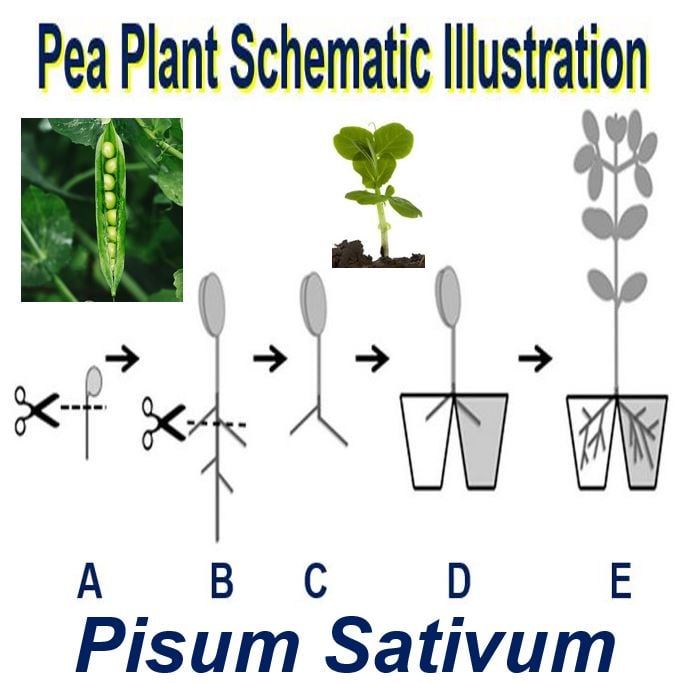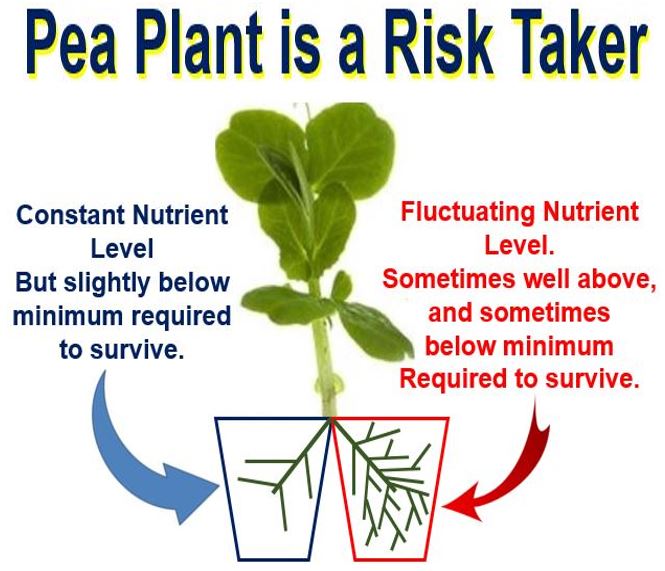Did you know that pea plants are good at making strategic survival decisions? In fact, their dynamic decision-making skills very similar ours, according to a study carried out by scientists at Oxford University in England and Tel-Hai College in Israel, who found that pea plants can demonstrative sensitivity to risk.
Apparently, pea plants can make adaptive choices that factor in environmental variance – an ability we previously thought only animals had. Perhaps the expression ‘pea-brained’ is not that apt, after all. Even though plants do not have a brain or nervous system, they are willing to take seemingly calculated risks in order to survive.
Efrat Dener, a master’s student at Ben Gurion University in Israel, and colleagues wrote about their latest study in the scientific journal Current Biology (citation below).
 This image is a schematic illustration of the root-splitting technique and irrigation scheme. (A) The root tip of four-day old pea plant (P. sativum) seedlings was removed. Over the next ten days (B), lateral roots grew out from the cut zone. All the later roots except for the two most similar ones were removed (C). Each root was placed in a separate pot, making sure that no fertilizer or water could seep from one pot to the the other (D & E). (Image: Current Biology)
This image is a schematic illustration of the root-splitting technique and irrigation scheme. (A) The root tip of four-day old pea plant (P. sativum) seedlings was removed. Over the next ten days (B), lateral roots grew out from the cut zone. All the later roots except for the two most similar ones were removed (C). Each root was placed in a separate pot, making sure that no fertilizer or water could seep from one pot to the the other (D & E). (Image: Current Biology)
The scientists grew pea plants with their roots split between two pods, which meant they had to decide which pot to prioritise, i.e. which pot in which to dedicate more resources and grow more roots.
In their first experiment, they found that the plants grew more roots in the pot with higher levels of nutrients. This is an adaptive response similar to humans and other animals, which allocate greater foraging efforts to patches with more food.
In a series of further experiments, the roots were then split between two pots with the same average nutrient concentrations, however, one pot had a constant level while in the other’s level fluctuated. They wanted to find out which pot the plants would chose to grow more roots in.
Humans and animals faced with such circumstances would tend to prefer the patch of land with varying concentrations of food when average levels were low, and the constant food patches when average levels were high.
 If you are stranded far from home, without any money. Which option would you choose if a ticket home costs $900 – flipping a coin with a 50-50 chance of getting the $900 or zero, or a guaranteed payment of $800? Most people would opt to flip the coin. Plants make the same choice when faced with similar survival situations.
If you are stranded far from home, without any money. Which option would you choose if a ticket home costs $900 – flipping a coin with a 50-50 chance of getting the $900 or zero, or a guaranteed payment of $800? Most people would opt to flip the coin. Plants make the same choice when faced with similar survival situations.
This is because when the average nutrient level falls below what is required for a life form to survive, the variable option at least offers some chance ‘to gamble’ on a run of good fortune. On the other hand, however, when average conditions are good, it seems more sensible to choose the safer option.
The scientists predicted that the plants would do the same – and that is exactly what happened. When their backs were against the wall, they literally went for ‘double or nothing’.
Plants are dynamic strategists
Co-author Professor Alex Kacelnik, who works in the Department of Zoology at Oxford University, commented:
“To our knowledge, this is the first demonstration of an adaptive response to risk in an organism without a nervous system.”
“We do not conclude that plants are intelligent in the sense used for humans or other animals, but rather that complex and interesting behaviours can theoretically be predicted as biological adaptations – and executed by organisms – on the basis of processes evolved to exploit natural opportunities efficiently.”
“We do not yet know how the plants’ sense variance functions, or even if their physiology is specifically adapted to respond to risk, but the findings lead us to look even at pea plants as dynamic strategists and to model their decision processes just as one would model an intelligent agent.
 The pea plant is a risk-taker, just like humans and other animals are. Rather than opt for the safe and constant nutrient level, but which would not be enough to survive, it gambles on maybe getting more than enough, even though there is also a chance of obtaining very little or nothing.
The pea plant is a risk-taker, just like humans and other animals are. Rather than opt for the safe and constant nutrient level, but which would not be enough to survive, it gambles on maybe getting more than enough, even though there is also a chance of obtaining very little or nothing.
Plants like us can be ‘risk prone’
The scientists explained that what the pea plants had to face would be similar to the following situation for humans:
Imagine you had to choose between receiving a guaranteed $800, or flipping a coin with a chance of receiving either $1,000 or nothing – a heads or tails possibility, i.e. 50-50. Which one would you choose?
Most of us realise that the guaranteed $800 option pays more on average. However, imagine you have no money and are stranded in a remote place, and the fare to get back home costs $900, and you are allowed just one flip of the coin.
The coin toss gives you a 50-50 chance of obtaining enough money to get you home, while with the ‘safe’ option you won’t have enough.
The pea plants seemingly perceived their options in the same way. They were ‘risk prone’ and grew more roots in the fluctuating pot – the unpredictable one – when the mean nutrient concentration in both pots was less than 0.01g/L.
However, when the mean nutrient concentration was at least 0.15g/L, the pea pots were ‘risk averse’ – they grew more roots in the constant pot.
First author Ms. Dener said:
“Like most people, including even experienced farmers and gardeners, I used to look at plants as passive receivers of circumstances.”
“This line of experiments illustrates how wrong that view is: living organisms are designed by natural selection to exploit their opportunities, and this often implies a great deal of flexibility.”
Dr. Hagai Shemesh, from the Department of Environmental Sciences at Tel-Hai College, added:
“To see that decision-making models developed by economists for human decision makers and by zoologists to understand animal behaviour can predict the behaviour of plants facing similar choices is fascinating, and points to many interdisciplinary research opportunities.”
“We are eager to present subjects with batteries of tasks requiring adaptive responses, exploring the extent to which optimality considerations proposed for brained agents anticipate the solutions evolved by plants.”
In the article in Current Biology, the authors wrote:
“We do not yet know the precise root allocation rules followed by Pisum, but finding that they can switch from risk proneness to risk aversion is a tantalizing discovery that will hopefully further promote the integration between the study of animal decision making and plant adaptive physiology.”
Citation: “Pea Plants Show Risk Sensitivity,” Efrat Dener, Alex Kacelnik and Hagai Shemesh. Current Biology. 30th June, 2016. DOI: 10.1016/j.cub.2016.05.008.
